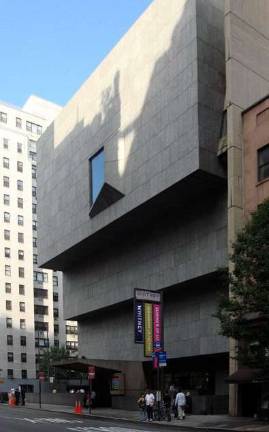The Transformation of the Whitney

The Whitney Museum is half way through the big move from its Upper East Side home to a new facility downtown The Whitney Museum has been house-hunting for years. After almost five decades in its current home, the Marcel Breuer-designed building on the Upper East Side's Madison Avenue, the famed modern and contemporary art museum is preparing to pack up and move downtown. The move is an answer to some of the problems that have beset the current facility ? difficulties expanding or renovating such a unique space combined with resistance from the quiet community and budgetary issues ? and will give the Whitney a chance to spread its artistic wings and start a brand new life cycle. But what's to become of the Breuer building uptown? And why is the Whitney fleeing its longtime home, in a neighborhood well known for arts patronage? One of the biggest reasons for the move is to get more space for the Whitney's vast collections. As a spokesperson for the Museum said, "The decision to move was very simple?the building was built in 1966 for a 2,000-piece collection, which has since grown to 20,000." After years of searching for other places uptown, the Whitney finally decided to go back to its roots in Greenwich Village, where Gertrude Whitney Vanderbilt founded her studio in 1930. The new building will be located in the Meatpacking District, situated right next to another modish construction, the High Line, overlooking a priceless view of the Hudson River. Well, not exactly priceless. In 2009, the museum signed a contract with the city's Economic Development Corporation to buy the city-owned site at Washington and Gansevoort Streets for $18 million. Mayor Bloomberg agreed to cut a 50 percent discount to insure the establishment of "a major cultural anchor for the new park." Designed by the Italian architect Renzo Piano (of the Centre Pompidou in Paris), the downtown museum promises to be a sleek-and-sophisticated facility. As the artist explains on the Whitney's website: "Here, all at once, you have the water, the park, the powerful industrial structures and the exciting mix of people, brought together and focused by this new building and the experience of art." By building six floors of cascading terraces, Piano will increase the Whitney's gallery space by 60 percent and triple its current total space. The 200,000 square foot property includes 50,000 square feet of indoor galleries, 13,000 square feet of outdoor exhibition space, an additional 18,000 square-foot gallery for temporary exhibitions and a lobby gallery-not to mention a contemporary artists' project space on the top floor and an entrance plaza doubling as a "public gathering space." The new home doesn't come without a price, of course. The building construction alone costs $422 million, while building its "capacity" (for artistic and educational programming) is another $113 million. It didn't help that the economy crashed just after the contract was signed. Yet the project has already raised 77 percent of its total goal. More than 80 percent of that has come from fundraising, requiring the Whitney to sell off only $95 million in real estate assets. The rest has come from an unforeseen benefactor with great expectations for the Madison Avenue building. The Metropolitan Museum of Art has agreed to ease the Whitney's untenable financial burden of maintaining two museums by taking over the Breuer building in 2015 for a period of eight years, at which point the lease on the Piano building also comes up for renewal. The spokesperson from the Whitney says that it is unlikely that they would undo the swap, which presents a win-win situation for both museums. The added exhibition and event space will allow the Met to enlarge its presence in the modern art world, and the Whitney to ensconce itself in the world of local artists, students and tourists downtown. The Breuer building is here to stay for an "extended [if unspecified] period of time," as Leonard A. Lauder, emeritus chairman of the museum, stipulated in his $131 million donation to the project. What happens next is future history, but the spokesman confirms that they are more than half-way finished and "everyone is looking forward to it."